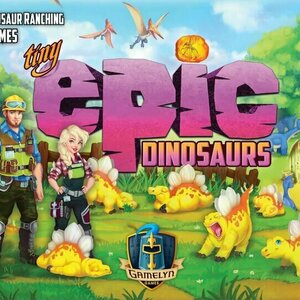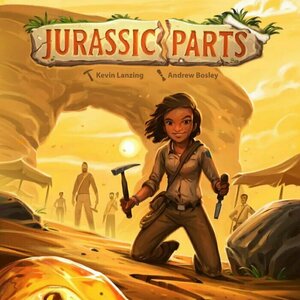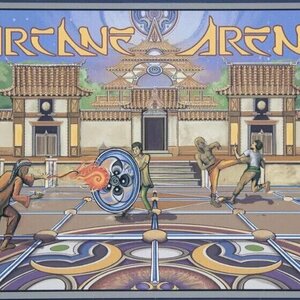
Super Big 2
Games and Entertainment
App
Big 2 is a popular poker game, with rules easy to learn. It is very dynamic and exciting intense....
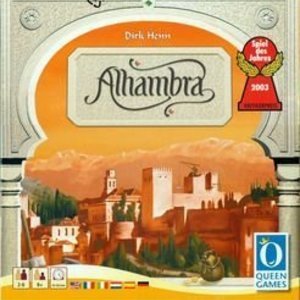
Alhambra
Tabletop Game
Granada, 1278. At the foot of the Sierra Nevada mountains, one of the most exciting and interesting...
Boardgames ModernClassics TonsofExpansions
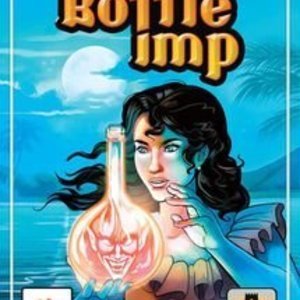
The Bottle Imp
Tabletop Game
In this trick-taking game based on the short story by Robert Louis Stevenson of the same name, the...
Cardgames TricktakingGame GatewayGames
Purple Phoenix Games (2266 KP) rated Tiny Epic Dinosaurs in Tabletop Games
Jul 13, 2021
Tiny Epic Dinosaurs (TEDinos) is the latest release in the Tiny Epic line from Gamelyn Games and is a worker placement game of dinosaur enclosure, husbandry, and contract fulfilling for up to four enterprising ranchers. Players will be acquiring dinosaurs and barriers, feeding them, breeding them, and attempting to fulfill public and private contracts for maximum VP gains.
DISCLAIMER: I will be presenting this as a Solo Chronicles, where I will be using the Solo Rules included in the TEDinos rulebook. Also, I will not be covering every rule, as there are just too many to describe, but will give a general flow and feeling of the game to help inform your purchasing decision. -T
To setup TEDinos, follow all setup rules in the rulebook until you have something that looks like the photo above. All of the setup, save a few steps, is exactly like setting up for a multiplayer game, and the solo player will be playing the game exactly as if it were multiplayer.
The game lasts six rounds and each round is comprised of seven phases. The phases contain actions to be taken like Collect Resources (plants, meat, and supply boxes), Assign Ranchers (the meat of the worker placement game where your rancheeples and Lead Tomvaseleeple will be placed on action spaces), Retrieve Ranchers (to use them again next round), Arrange Ranch (to place your dinos in different enclosures), Feed Dinosaurs (obvious), Breed Dinosaurs (every like pair of dinos make a like dino), Refresh for Next Round (resetting card stacks and offers).
Again, I won’t go into detail about these phases, but will detail how the solo game differs a bit from the multiplayer. The Rival Rancher (AI player) will be taking actions in the second phase of every round, Assign Ranchers, but will do it using a card deck specific to the Rival Rancher. Initially the Rival Rancher will be 1st Player, so they will play a card from their deck during Assign Ranchers that will claim all of the action spaces on one of the Action Mats and give them a dineeple. For the player, should they wish to claim a spot on the same Action Mat that the Rival Rancher is sitting on, it will count as a meeple being there, so the player will need to expend their Lead Rancher or two normal Ranchers to claim a space.
This simulates another player claiming a space prior to the player’s turn, and spaces are still available, but with the added challenge of holding the Rival Rancher’s meeple. Play continues in this fashion until the end of the sixth round where player and Rival Rancher alike will add up VP to determine the winner.
Components. Like all Tiny Epic games, there are a TON of components packed into a tiny box. That is both a great thing and a challenging thing. TEDinos takes up about half of my dining table when all setup and played. So it does sprawl a little. However, many of the components are very very small and for big oaf-hands, the pieces can be fragile and cumbersome. It looks great on the table as the color palette used is fantastic (especially against a purple play surface), and the art is superb. All the components are great quality, but the meeples suffer a bit as they are so small; my copy came with several dineeples being damaged or headless or tailless or legless. That doesn’t necessarily bother me too much so I won’t bellyache about it. All in all the components are what we now expect from the Tiny Epic line.
The solo gameplay is really good and really REALLY difficult. I feel that if you don’t go into the game with a strategy ready to go you will flounder and be overwhelmed by the prowess of the AI Rival Rancher. I was the first time and I thought I would never be able to even come close to winning. But, the more I play the more I recognize different tactics to use in-game to help benefit my ranch effectively. Each AI player can use a different mat that offers different AI strategies and those are found on the back of the normal multiplayer mats. This is a phenomenal idea and offers great replayability, even for the solo plays.
Though the solo rules of TEDinos allow the AI player to be super tough, I find this to be one of the best in the Tiny Epic line. Tiny Epic Galaxies may still be my favorite, but I think TEDinos might be right behind. I can’t wait until this dino dropping-like virus is eradicated so I can play with my homies again, because I will certainly be pulling this one out quite a bit. I keep a spreadsheet of all my games in order of preference, and I admit that TEDinos has easily whomped its way into my Top 100, but will it get to Top 10 Games of All Time along with Tiny Epic Galaxies? I don’t know. Want to play and find out where it lands with you? Pick up a copy and have at it!
PS – I’m not one to shout out to other reviewers usually, but if you get a chance, do check out the Watch It Played video of this one. Rodney does a great job (as always) and helped me clear up some questions I had after reading the rule book.
Purple Phoenix Games (2266 KP) rated Jurassic Parts in Tabletop Games
May 31, 2021
Jurassic Parts is an interesting mix and spins of area control, enclosure, and set collection for two to five players. In it, players are all paleontologists bent on claiming the biggest and best bones from a giant slab of rock containing dozens of dino species. The catch? Each paleontologist is trying to claim the bones for themselves. Sharp wit, good luck, and a bevvy of sharpened chisels spells success and fame for the paleontologist who wins at collecting Jurassic Parts.
DISCLAIMER: We were provided a copy of this game for the purposes of this review. This is a retail copy of the game, so what you see in these photos is exactly what would be received in your box. I do not intend to cover every single rule included in the rulebook, but will describe the overall game flow and major rule set so that our readers may get a sense of how the game plays. For more in depth rules, you may purchase a copy online or from your FLGS. -T
To setup, set aside one of the Pile of Bones (a wild card, of which there are several in the game) and shuffle the rest of the tiles. Split them into two stacks, flip one stack face-down, and build a slab around the Pile of Bones set aside earlier. This creates the slab of rock the players will be splitting. Each player receives their choice of paleontologist character sheet, chisels in their chosen color, and any pre-start resources per the rulebook. The slab is now ready for splitting!
On a turn, the active player will have several options. Firstly, however, the player must sharpen three chisels by moving them from the Dull Chisels are on the right of their sheet to the Sharp Chisels area on the left. Now the player may place their chisels anywhere on the slab, as long as it is on the gap between two tiles. The purpose of this is to create a wonky line of chisels that will break off sections of the slab from the larger chunk. Players will need to beware of rock piles on either side of their preferred placement, as each rock icon on either side of the placement will require an extra chisel to be dulled and discarded. If a chisel placement would cause a line to be completed, a hunk of the slab is separated from the master slab. Players consult with the line of chisels (as shown below) to determine which player has contributed more to the split than the others. This will rank out all contributing players. The player with the most chisels contributed will be able to claim their choice of HALF of the tiles split off, rounded UP (so a player would receive five tiles from a nine-tile split). The next player in contribution order will then have their choice of HALF of the remaining tiles, rounded UP (so the second player would receive two tiles from the previous example, as there would be four left). Subsequent players would then receive HALF of what is left until all tiles have been claimed, or there remains just one tile. This final tile is then given to the Field Leader for his collection.
In addition to this splitting and claiming on a turn, the active player may also make transactions with the Field Leader at any point during their turn. Actions that can be taken while transacting with the Field Leader are selling one tile to him in exchange for an Amber piece, spending Amber to: ignore rocks on the subsequent two chisel placements, sharpen two additional chisels this turn, take any of the leftover fossil tiles from the Field Leader, or take any fossil tile from the slab (as long as it doesn’t create a split). The first action from the Field Leader will cost the player one Amber. Should they wish to enact another action, its cost is two Amber. Subsequent actions on the same turn cost three Amber each.
As you will notice, fossil tiles from the slab will show plant fossils, Pile of Bones (wild), or actual bones belonging to specific dinosaurs. These specific bones will show an alphabetic letter pair icon to denote to which dinosaur it belongs. If, at the end of the game, players are able to assemble the correct type of fossil tiles belonging to specific dinosaurs, they will score many more points than if the dino skeleton were incomplete. For example, at the end of the game, each fossil tile is worth 1VP if from an incomplete skeleton. However, should a player have completed a Velociraptor skeleton, they will receive 4VP for those two tiles. A completed Triceratops scores 7VP, a T-Rex scores 10VP, a Brachiosaurus scores 15VP, and a tiny Pterodactyl scores 1VP for a complete skeleton because it spans only one tile. The Pile of Bones tiles in the game can be used in place of any other fossil tile to complete a skeleton, and Plant tiles score increasingly more points for a larger collection of them.
Play continues in this fashion of sharpening and placing chisels, breaking off sections of the slab and claiming fossil tiles, and utilizing actions at the Field Leader until all slab tiles have been assigned. The player with the most points from complete and incomplete skeletons and plants will be crowned the winner and the greatest paleontologist in the land… until the next playthrough.
Components. You know how you come to expect certain things from publishers, and can just imagine the quality of the game you are about to receive before seeing it? Such is the case with 25th Century Games. I KNOW that I will be receiving a quality product every time, and this certainly is no exception. The fossil tiles are great and sturdy. The chisels are neatly-designed and multifaceted (which I appreciate, as it would be easy to include tubular chisels and have them rolling around the table everywhere). The amber bits are the typical gemstones you find in Century: Golem Edition, but are the absolute PERFECT color and usage for this game. And did you see that first player marker? It’s a mosquito inside a polished amber stone. I mean, COME ON! How perfect is that? I’m excited just TALKING about the components. I haven’t even touched on art yet, and this is longer than most of my components paragraphs. The art is fabulous. It fits the game and the theme so perfectly – I could not have chosen a better fit myself. Has 25th Century Games set the bar too high for themselves, or will they continue to offer high quality games from here on out? I cannot wait to find out!
So sure, it looks great, but what about the gameplay? Do the art and components merely shield a mediocre game? No. Not at all. Being able to place chisels anywhere you like on the board offers players a freedom that is refreshing, but weighing that against the pressure to contribute to an existing or emerging line of chisels so that you are included in the split is just wonderful. Contemplating turns to sell off fossil tiles in order to earn enough amber to gain more chisels, or bypass rocks, or simply take the perfect tile for your collection offers just enough tacticization (why isn’t that a word…) to warm up the brain without indulging the AP in some players.
This is not at all a heavy game, and it certainly doesn’t need to be. It is just a fun time with friends and family that utilizes interesting twists of mechanics that I enjoy. It feels reminiscent of several games (hints of Through the Desert and a twist on I Split You Choose), but it entirely its own design. Purple Phoenix Games gives this one very rewarding 10 / 12. I generally enjoy most dinosaur-themed games, I understand, but this one sits among the best I have played. If you are looking for something that feels both familiar and fresh, with incredible art and components, you need to grab a copy of Jurassic Parts. There are just so many interesting choices to be made and strategies to attempt. I think I will setup a game right now. Want to come play?
Purple Phoenix Games (2266 KP) rated Arcane Arena in Tabletop Games
Jan 23, 2021
Arcane Arena is an arena-style fighting card game. In it players will take on the mantle of a warrior competing in this brutal last-man-standing battle royale. They will need to train and learn new techniques and then show their opponents all they have learned. The game takes place over three rounds of increasing actions and, truly, the last warrior standing will be crowned Champion!
DISCLAIMER: We were provided a prototype copy of this game for the purposes of this review. These are preview copy components, and I do not know for sure if the final components will be any different from these shown. Also, it is not my intention to detail every rule in the game, as there are just too many. You are invited to download the rulebook, back the game through the Kickstarter campaign, or through any retailers stocking it after fulfillment. -T
To setup, refer to the rules to deal each player their starting deck of Buy, Move, and Attack cards. Remove all Focus and Wound cards and make a stack for each on the side of the play area. Shuffle the remaining “Trainer” cards and create a market of six cards to be purchased. Set the arena board on the table and populate it with player tokens and Favor tokens (glass beads in this prototype). Each player shuffles their starting deck and draws four cards to create their starting hand. The tournament is now prepared for warriors.
Arcane Arena features three rounds of two phases each. The first round has players limited to three turns during the first training phase and 10 hit points for the second phase of the game.
The first phase of each round is the Training Phase. During this phase players are able to use their four cards “as a buy” for their purchasing power. The player lays a card, announces it is as a buy, tallies the currency to be spent, and then purchases a card from the collection of six cards in the offer or one Focus card from its stack. Once completed with their Training Phase, the player will restock the trainer pool of cards for purchase. It is then the next player’s turn to complete their Training Phase.
Once all players have had their Training Phase, the Combat Phase begins with the active player. The active player must play cards for either their Move, Effect, or Attack keywords. Each card will instruct the player the amount of Move they can use, which Effect can be used and how, and how many Attack points of damage they inflict on a target within range.
Play continues in this fashion with each player playing as many cards from their hand of four as they wish until only one player remains with hit points. If it is the third such round of Combat Phase (5 turns at the Training Phase and 20 HP during Combat) then the last player standing is the winner!
Components. Again, this is a prototype copy of the game, so some components will be different from the finished version. That said, this game has decent components planned and the art style is interesting, with hints of a more ancient style. The iconography on the cards is okay: I did find myself trying to figure out what the icon for “purchase” actually was, so it threw me off a couple times. Similarly, the effect bar on the card is very small and can easily be overlooked if the players are not constantly checking for that bar for information.
Gameplay for Arcane Arena is something with which I am struggling to describe. I have always been poor with arena-style games that have players moving around and attacking. It is so difficult for me to abandon my Barbarian-style of just blocking movement and wailing on a stationary enemy. Once movement is expected I am a fish out of water. That is not at all a knock on Arcane Arena, but on my style of play. However, if I belong to a group of gamers with similar style be warned: there’s a lot of opportunity for movement here and it may be uncomfortable at first.
I do like the theme of the game and its implementation. I can understand the premise and relate it to the gameplay. I like that it is split between two distinct phases and having cards with multiple usage is a positive for me. I also enjoy that every time a new phase begins all players combine their cards, shuffle, and draw a hand of four cards. This is new for me, as in typical deckbuilders the card just purchased usually goes directly into the discard pile only to be drawn on much later turns. Such is not with this one. A card just purchased may be drawn immediately in the next Combat Phase, depending on luck of the shuffle and draw.
So while I do not enjoy the moving around the arena aspect of the game, all else is good for me. If you are similar to me I would say give it a shot, but it may be difficult to be successful if, like me, you plan to be a stalwart rock instead of a nimble wisp. If Arcane Arena sounds like your cup of tea, do check it out when it comes available!
Purple Phoenix Games (2266 KP) rated Holi: Festival of Colors in Tabletop Games
Apr 16, 2022
Holi is an abstract, area control, card-driven action selection (akin to Onitama) game for two to four players. In it, players are attendees at the Holi Festival and the goal is spread their favorite color onto the plaza and other players in order to increase their joy (earn VP). The winner is the player who is best able to throw their color and score joy, all while enjoying the festival!
To setup, the game owner will assemble the three-tiered board and place the appropriate sweets tokens on their spaces. The score track and Rivalry cards are set nearby so all can see. Each player receives their color’s player markers (in four delightful animal shapes), color tokens, color cards, and a helper card. The first player receives the cool lotus flower (I think) marker and the game may begin!
Holi is played over a series of turns, and continues until every player has either run out of color tokens or color cards to play. Each turn, players will take one to three actions in any order, with only one action being absolutely mandatory. This is the Throw Color action. In order to Throw Color, the active player will choose a color card from their hand of three cards to play. On these cards are indications of where a player’s marker/piece/animeeple must be located and the spaces near it to throw color tokens on the board. These color cards are reminiscent of those found in Onitama, where players may only move to specific spaces based on card grid iconography. Players will be littering the squares of the play area with their color tokens as well as attempting to hit other players’ animeeples with their color.
Players may also optionally Move at any point during the turn. This is an easy one: players may Move to any space on the current level of the board they are on, except any space inhabited by an opponent’s animeeple. These spaces could already contain sweets tokens, which can be collected by the player, or even color tokens. When a player lands in a space with their own color token, they take it back to their supply to be used again. However, landing on an opponent’s color token causes the active player to also take it into their supply, thus scoring the opponent points at the end of the game.
Finally, a player, if in a space surrounded on four edges by color tokens, may Climb Up to the next higher level. Players on the middle level will score 2 joy (VP) at the end of the game for each color token placed, while tokens on the top level will score 3 joy. Care should be taken when throwing color on the upper levels, because should an empty space reside on the level below where the token has been placed, the token will fall through to the lower level! Therefore, only color tokens will only remain placed on higher levels when another token is blocking its fall below it.
Once all players have played their cards and thrown their color tokens, the game is over and the score is tallied. 1 point is earned for each color token on the bottom level, 2 points for the middle level, and 3 points for tokens on the upper level. Players score 2 more points for each of their color tokens that found their way into opponents’ supplies. Remember those sweets tokens that players were collecting? Players will score 5 points for every player that has less sweets tokens at the end of the game. If playing with the Rivalry cards, points are also scored for any of their special circumstances (ie color tokens scoring 4 instead of 3 on the top level, or hitting opponents with colors score 2 points immediately instead of the normal 1 point, or even 10 bonus points to the player with the most color tokens on the bottom level). The player with the most points at the end of this scoring phase wins the game!
Components. I kind of already made my point about this game being a flat out stunner on the table. I will sing its praises from here to India and then back again. I normally acknowledge the artist(s) on a game once I open it for the first time, but seeing that this is a total Vincent Dutrait masterpiece, I just had to see which other games of his I own. I have made my claims in the past for my favorite board game artists and I had not included Dutrait. No more. This is brilliant and just a wonderful experience throughout. The components are all great, and that multi-layered board? I mean, come on! The intricacies found throughout and within this box are immeasurable, and I will surely be adding the Deluxe version to my collection.
Holi is a game I can pull out with almost any person or group of people and feel confident that it will give an extremely satisfying experience. The rules are relatively simple, and games are very quick. This is not a filler, but runs so smoothly and briskly that one may miscategorize it as such. The options of movement are so unrestricted, and having the ability to craft spatial situations with the cards in your hand to allow only your animeeple to climb up to the next level is just delicious. Speaking of, the sweets tokens, and really ALL of the components, are just so cute and well-illustrated. I really am finding it difficult to point out any flaws in this game. Every time I have played it I have simply had the best time with my opponents. Yeah, there’s some minor take that, but it’s all in good fun, and if you know anything about the actual celebration of Holi, participants relish coming home just covered head to toe in paint, colored water, and other colorful materials. It’s a great theme that shines through, and I look forward to each of my coming plays.
Currently, eight games we have published reviews for have earned the Golden Feather Award. At the time of this writing, I know one other will be joining that list soon, and now Holi will as well. So that is 10 total games over the 495 we have published and are sitting in queue to be published. That said, it is no surprise, I’m sure, that Holi has earned its spot among the best we have played, and I am incredibly relieved that I was able to grab a copy when I did. This will remain a favorite of mine for many years, I know it. If you are like me and appreciate an amazing production value with a comparably wonderful game underneath, then you owe it to yourself to pick up a copy of Holi as soon as you can. Or come play my copy with me. I will always be up for a play.
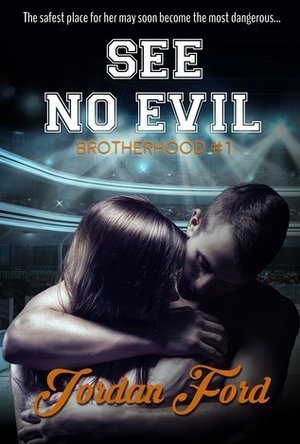
See No Evil (Brotherhood, #1)
Book
All Christiana wanted was a little flirty fun. What she got was a one-way ticket to her own...
Contemporary Young_Adult Romance Suspense

First Impressions (Auckland Med. #1)
Book
Michael: Two years ago, I made a mistake, a big one. Then I added a couple more just for good...
Contemporary MM Romance
